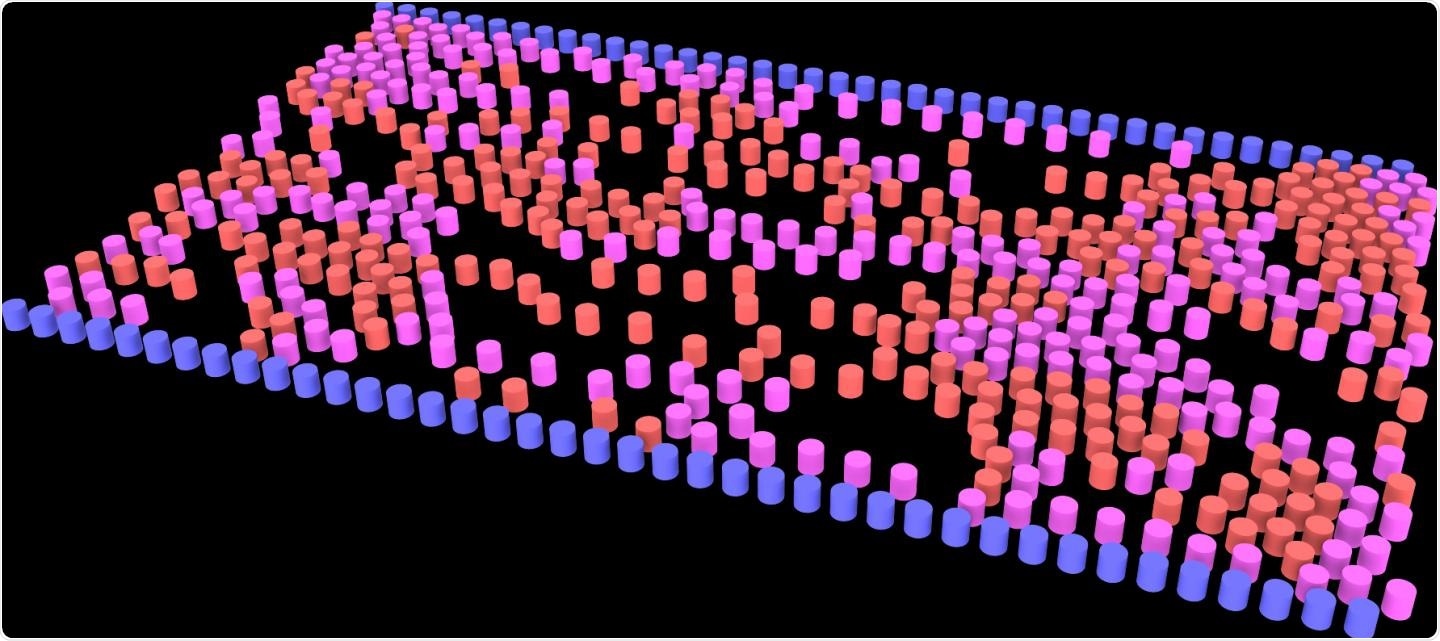The coronavirus disease, caused by the agent severe acute respiratory syndrome 2 (SARS-CoV-2) wreaks havoc across the globe, with its second wave occurring in many countries.
With the winter season fast approaching in the northern hemisphere, more people will stay indoors, which could lead to greater virus spread. Past studies have shown that indoor spread of the virus, especially in offices, grocery stores, concert halls, and other places with less ventilation, may ramp up as the cold season kicks in.
At the 73rd Annual Meeting of the American Physical Society's Division of the Americal Physical Society's Division of Fluid Dynamics, researchers presented a range of studies investigating the aerodynamics of infectious disease.
One study results revealed that the number of micron-scale expiratory particles emitted during vocalization, such as singing or speaking, dramatically increases with loudness. The number of virus particles is also increased markedly by coughing.

Simulation of pedestrian counterflow (red and pink particles) confined within a hallway (blue boundary), under conditions of weak social distancing. CREDIT Kelby Kramer and Gerald J. Wang
How COVID-19 spreads
The SARS-CoV-2 primarily spreads through contact and respiratory droplets. Under some circumstances, the airborne transmission may happen, such as when aerosol-generating procedures are performed in healthcare settings, when in crowded indoor environments with poor ventilation, and when people speak, breathe, or sing.
The U.S. Centers for Disease Control and Prevention (CDC) updated its guidelines, acknowledging that SARS-CoV-2 spreads through aerosols. The World Health Organization (WHO) also recognized the coronavirus's potential to spread via aerosols, hence, recommends people to avoid closed areas with poor ventilation.
With the potential of airborne transmission, the health agencies reiterate the importance of basic infection protocols to prevent infection, such as wearing masks, physical distancing, and regular hand hygiene.
Virus spread by singing and speaking
Past research has shown the role played by large, fast-falling objects produced by coughing or sneezing. In some superspreader events, people got infected with SARS-CoV-2 when they were with other people indoors. For instance, of the 61 singers in Washington state, 53 contracted the virus after a 2.5-hour choir rehearsal in March. In another incident, 24 of the 67 passengers who were on board a bus for two hours got infected with the virus in Zhejiang Province in China.
In one report, William Ristenpart, a chemical engineer at UC Davis, revealed that when people speak or sing loudly, they generate more micron-sized particles compared to when they use a normal voice.
"Theoretical calculations suggest that vocalizing less often and more quietly yields substantial decreases in transmission probability," the report explained. Further, the report added that the particles produced when shouting or yelling greatly surpass the number produced during coughing.
In experiments in guinea pigs, study researchers emphasized that influenza is transmitted via aerosolized fomites, which are virus-contaminated dust particles released from animals' fur and cages, not from their expiration. The team concluded that these fomites could be released from sources regularly used by people, including tissue papers.
"Our results suggest that researchers should expand their focus beyond coughing and sneezing as the presumed mechanism for airborne disease transmission," the study authors concluded.
Spread via musical instruments
Another study by researchers from the University of Colorado, Boulder, focused on how the virus might spread through musical instruments. The team conducted experiments to measure aerosol emissions from musical instruments.
The team said that flutes, for instance, do not generate that many aerosols when used. However, instruments such as oboes and clarinets, which have wet and vibrating surfaces, tend to produce many aerosols.
Aerosol emissions from musical instruments can be controlled. When a mask is placed over a trumpet or clarinet bell, it reduces the number of airborne particles back down to levels in a normal tone of voice.
Meanwhile, a research team at the University of Minnesota revealed that though the amount of aerosols produced differ by musician and instrument, they rarely traveled more than a foot away. Hence, the team designed a pandemic-sensitive seating model for live orchestras. They also decided where to place filters and audience members to reduce the risk of virus spread.
In the workplace
During the pandemic, many employees opted to work from home. As restrictions are eased, employers are exploring ways to safely reopen their workplaces by sustaining physical distance among their employees. A team of researchers at Carnegie Mellon University used two-dimensional simulations that modeled people as particles. They identified specific conditions that would help avoid crowding in confined spaces such as hallways.
One of the problems employees face amid the global health crisis is commuting to and from office buildings. Since passenger cars also pose an infection risk, a team of researchers at Brown University computed how air moves through passenger car cabins to determine strategies to reduce the risk of virus spread. For instance, opening some windows strategically while closing others can help reduce the risk.
As the new normal starts to set in among many countries identifying ways to reduce virus spread is crucial to combat the COVID-19 pandemic.